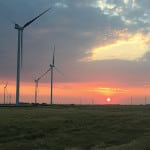Decarbonization is a word that seems to be used quite regularly these days. For the power industry, it refers to the shift in electric generating resources from carbon-heavy coal to carbon-free nuclear or renewables, including wind, solar, and hydro. Many politicians have espoused clean-energy plans, but it’s not just lawmakers promoting decarbonization, as power companies are setting their own aggressive goals.
Three of the largest power utilities in the U.S.—Duke Energy, American Electric Power (AEP), and Xcel Energy, which rank as the third-, fourth-, and sixth-largest companies, respectively, based on market capitalization in TD Ameritrade’s electric utility industry breakdown—have set aspirational targets of producing net-zero carbon emissions from electric generation by 2050. Several other large utilities have similar net-zero goals.
Duke Energy Banks on Solar
I had the opportunity to hear Duke Energy CEO Lynn Good speak during a panel discussion at the BloombergNEF Summit in New York in March. She noted at the time, “We’re continuing progress toward clean energy. For Duke that means renewables, that means battery technology, and that means natural gas.”
Duke Energy is headquartered in Charlotte, North Carolina, and it has a large footprint in the state—3.4 million retail electric customers. Good noted that North Carolina ranks second in the nation in installed solar capacity behind only California, and it is Duke Energy’s biggest solar state. In July, the company reported owning 40 solar facilities in North Carolina, including the 80-MW Conetoe Solar Facility in Edgecombe County, the 65-MW Warsaw Solar Facility in Duplin County, and the 60-MW Monroe Solar Facility in Union County.
But that’s not all. Duke Energy’s owned and operated solar portfolio includes a total of almost 70 sites in 10 states, with capacity of 1.1 GW. Furthermore, the company is one of the largest purchasers of solar power in the nation. It currently purchases the output from more than 3 GW of capacity in states where it serves retail customers. Taken together, the 4 GW of owned and purchased renewables make up more than 9% of Duke Energy’s generated electricity.
Wind Power Drives Xcel Energy
Xcel Energy hired climate modeling experts to evaluate the company’s emissions reduction targets and to get a better understanding of how its vision relates to global temperature goals. In February, Xcel Energy published a 28-page report detailing its plan for a carbon-free energy future. However, the company didn’t just start decarbonizing its generation assets this year, it’s been significantly reducing emissions for a long time.
Xcel Energy reported that its company-wide carbon emissions in 2018 were 38% less than 2005 levels. Although solar power is part of the Minneapolis, Minnesota-headquartered company’s decarbonization strategy, its territory is better suited to wind power generation, and that’s where the utility has focused its efforts.
“[L]eading the clean energy transition continues to be a strategic priority for us,” Ben Fowke, chairman, president, and CEO of Xcel Energy, wrote in his opening statement of the report. “We’re a national leader in wind energy and are harnessing it through our Steel for Fuel strategy, which we expect to reduce costs for customers.”
Xcel Energy has plans to increase its wind portfolio 55% by the end of 2021. It has or will construct 12 new wind farms in seven states, adding nearly 3,700 MW of wind capacity to its system. The company noted that improved turbine technology has caused wind power costs to fall. Given the current low prices and available tax credits, Xcel Energy believes now is the time to invest in wind, providing customers with affordable clean energy for years to come.
As new renewable generation is added, Xcel Energy will retire existing coal resources. Under its currently approved plans, the company said 23 coal units would be retired from 2005 to 2027, which is about 50% of the coal-fueled capacity Xcel Energy owns.
AEP Mixes It Up
AEP’s plans are just as progressive as its peers, incorporating both wind and solar into its mix at substantial rates. With corporate headquarters in Columbus, Ohio, AEP’s service territory spans about 200,000 square miles over parts of 11 states.
Historically, the company has been a coal-heavy utility. As recently as 2005, 70% of its capacity was coal-fueled. This year, coal accounts for 46% of AEP’s generating resource portfolio. By 2030, the percentage is expected to drop to 27%. Over the same time period, hydro, wind, solar, and pumped storage are expected to grow tenfold to 40%.
Part of the company’s clean energy strategy is to add up to 5,050 MW of new wind and install up to 3,766 MW of solar capacity by 2030. It also plans to invest $2.2 billion in contracted renewables by 2023. A portion of that investment was made in April when AEP’s competitive renewable energy subsidiary, AEP Clean Energy Resources, completed the purchase of Sempra Renewables LLC and its 724 MW of operating wind generation and battery assets for approximately $1.05 billion. The deal included all or parts of seven wind farms in seven states, making AEP one of the largest utility owners of competitive wind projects in the nation. In July, the company added more wind capacity by purchasing 75% (227 MW) of the Santa Rita East Wind Project in Texas.
In the end, it seems decarbonization is becoming more of a business choice than a regulatory or policy-driven decision. Coupled with the public relations benefits, companies appear to find renewable energy to be a competitive option in today’s market, and leading companies are moving to decarbonize their asset portfolios. ■
—Aaron Larson is POWER’s executive editor.










